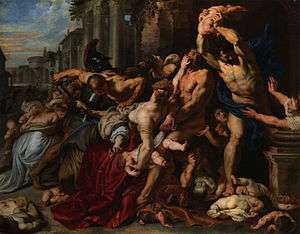Matthew 2:16

Matthew 2:16 is the sixteenth verse of the second chapter of the Gospel of Matthew in the New Testament.
Joseph and Mary had been visited by an angel and told that Herod would attempt to kill Jesus, their son. Doing as told, they took their infant son and fled by night into Egypt, where they stayed until Herod had died. The three Magi were separately warned in a dream of the threat that King Herod posed and went home by a different route than they came.
Herod had planned to make the Magi tell him of the whereabouts of the Christ child. When he hears of the Magi's change in course, he grew angry and tried to kill the infant messiah by killing all the young children in the area, an event known as the Massacre of the Innocents.
In the King James Version of the Bible the text reads:
- Then Herod, when he saw that he was mocked of the wise men,
- was exceeding wroth, and sent forth, and slew all the children
- that were in Bethlehem, and in all the coasts thereof, from
- two years old and under, according to the time which he had diligently
- inquired of the wise men.
The World English Bible translates the passage as:
- Then Herod, when he saw that he was mocked by the wise men,
- was exceedingly angry, and sent out, and killed all the male children
- who were in Bethlehem and in all the surrounding countryside, from
- two years old and under, according to the exact time which he had
- learned from the wise men.
For a collection of other versions see BibRef Matthew 2:16
Brown notes that the then, when construction is used throughout Matthew to indicate a change of scene as in this case where the narrative moves from the Holy Family to King Herod.[1]
The word empaizein is variously translated as deceived or mocked; in reality, Brown notes that the word is a combination of the two ideas and has no direct English translation.[2]
Clarke notes that the description of Herod as "exceeding wroth" has been central to Herod's perception and was the foundation for how the king was portrayed in the mystery cycles of the past and in modern popular culture.[3]
Jones notes that the term "surroundings" is a specific term referring to the rural areas around the village of Bethlehem. It does not refer to any other nearby towns or villages. At the time, Bethlehem was a small village and it and its surrounding area would have had a very small population.[4] Albright and Mann estimate the village would have had only some 300 people at the time,[5] Raymond E. Brown estimates it was around a thousand.[6] For all these figures, the number of children killed would have been less than twenty.[7] This number clashes with the traditional view of thousands of deaths, but it helps explain why the massacre was not mentioned by any historians such as Josephus. The killing of all the infants in a small village would have been only one of many massacres Herod is recorded to have carried out in his later years.[8] At the same time, Brown notes that the double word all shows that the author of Matthew is trying to portray a large massacre.[9]
Gundry notes that "two years old and under" properly refers to children who have not entered their second year, thus those twelve months old and younger. That Herod picks this number is considered an important clue to when Jesus was born.[10] It is taken to indicate that close to a year had elapsed since the birth of Jesus. Herod is believed to have died in 4 BC so based on Matthew, Jesus' birth is guessed to have been in 5 or 6 BC.
References
- ↑ Brown, Raymond E. The Birth of the Messiah: A Commentary on the Infancy Narratives in Matthew and Luke. London: G. Chapman, 1977.
- ↑ Brown, Raymond E. The Birth of the Messiah: A Commentary on the Infancy Narratives in Matthew and Luke. London: G. Chapman, 1977.
- ↑ Clarke, Howard W. The Gospel of Matthew and its Readers: A Historical Introduction to the First Gospel. Bloomington: Indiana University Press, 2003.
- ↑ Jones, Alexander. The Gospel According to St. Matthew. London: Geoffrey Chapman, 1965.
- ↑ Albright, W.F. and C.S. Mann. "Matthew." The Anchor Bible Series. New York: Doubleday & Company, 1971.
- ↑ Brown, Raymond E. The Birth of the Messiah: A Commentary on the Infancy Narratives in Matthew and Luke. London: G. Chapman, 1977.
- ↑ Nolland, John. The Gospel of Matthew: a commentary on the Greek text. Wm. B. Eerdmans Publishing, 2005 pg. 123
- ↑ France, R.T. The Gospel According to Matthew: an Introduction and Commentary. Leicester: Inter-Varsity, 1985. pg. 85
- ↑ Brown, Raymond E. The Birth of the Messiah: A Commentary on the Infancy Narratives in Matthew and Luke. London: G. Chapman, 1977.
- ↑ Gundry, Robert H. Matthew a Commentary on his Literary and Theological Art. Grand Rapids: William B. Eerdmans Publishing Company, 1982.
| Preceded by Matthew 2:15 |
Gospel of Matthew Chapter 2 |
Succeeded by Matthew 2:17 |
| ||||||||||||||||||||||
| ||||||||||||||||||||||||||||||||
